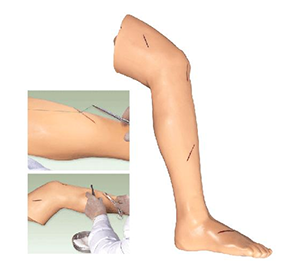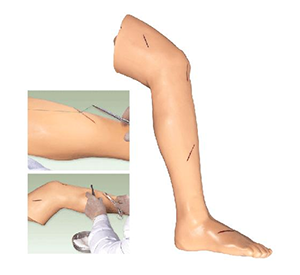Surgical leg suture training model has many unique features in medical education and surgical skill training, mainly reflected in the following aspects:
First of all, it is highly simulated. Usually made of advanced materials and technologies, it can realistically simulate the anatomical structure and physiological characteristics of real human legs. This high degree of simulation makes the model very close to the real surgical environment in terms of touch, visual effects and operational feedback, providing a training platform close to actual combat.

Secondly, the model design is scientific and functional. Not only the skin, muscle, bone and other tissue structures of the legs are simulated, but also a variety of wound types and suture scenes are designed, such as straight wound, curved wound, irregular wound and so on. This design allows students to perform a variety of suturing exercises on the model, including basic suturing, complex wound management, and emergency management in special situations, thereby improving their suturing skills across the board.
Furthermore, the model is easy to clean and maintain. Usually made of durable and easy to clean materials, this allows the model to be easily cleaned and disinfected after use, ensuring a hygienic and safe training environment. At the same time, the maintenance cost of the model is relatively low, and the training effect can be maintained for a long time.
In addition, the model also has teaching interactivity and repeatability. Through the surgical leg suture training model, teachers can make personalized training plans according to the actual situation of students, and carry out real-time guidance and feedback. Students can also perform repeated exercises on the model until they have mastered the stitching technique. This interactivity and repeatability helps to enhance the effectiveness of the training and ensure that the participants can truly master the skills they need.
To sum up, surgical leg suture training model plays an important role in medical education and surgical skill training due to its characteristics of high simulation, scientific design, easy cleaning and maintenance, teaching interaction and repeatability.

